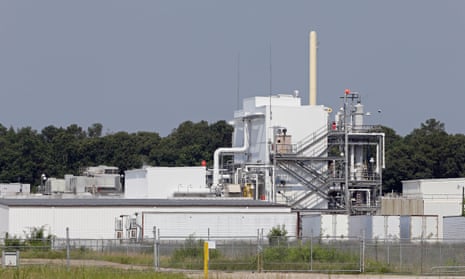At least 11 new kinds of PFAS “forever chemicals” are polluting the water around a North Carolina Chemours plant that manufactures the toxic substances, new research finds.
The discovery, made by researchers using a novel testing method, is evidence that the environment around the plant is more contaminated with PFAS than regulators have found, the researchers said.
“This means there are a lot more PFAS that people are being exposed to than they know,” said Erin Baker, a University of North Carolina PFAS researcher who co-authored the peer-reviewed paper published on Wednesday in the journal Science. “That’s because [regulators’ testing] is missing the PFAS because no one knows how to target them.”
PFAS, or per- and polyfluoroalkyl substances, are a class of about 15,000 compounds most frequently used to make products water-, stain- and grease-resistant. They have been linked to cancer, birth defects, decreased immunity, high cholesterol, kidney disease and a range of other serious health problems. They are dubbed “forever chemicals” because most do not degrade in the environment.
A 2019 state consent order required Chemours to rein in its Fayetteville Works’ site pollution for PFAS compounds produced or released from the facility. But most PFAS tests can only identify a limited number of PFAS.
Chemours, which was spun off from DuPont in 2015 to shield the latter from legal liability, is thought to be responsible for contaminating the air, soil, crops and water across potentially hundreds of square miles of south-east North Carolina with PFAS waste, according to public health advocates, regulators and researchers.
Many residents allege it has sickened people on a wide scale; a judge recently allowed more than 100,000 residents to move forward with a class-action PFAS lawsuit against DuPont and Chemours and the United Nations has been urged to investigate alleged human rights violations over the company’s pollution.
Researchers identified the PFAS compounds downstream from Fayetteville Works, but did not find them in a lake upstream from the plant, suggesting they were produced by Chemours. Some of the compounds are similar in structure to PFAS produced at Fayetteville Works, but others are highly unusual, Baker said.
It is possible that PFAS that have been studied are produced at Fayetteville Works and are turning into new compounds once in the environment.
“That’s where some of the questions come in about whether manufacturers are making things that they know can’t be [detected by current PFAS tests],” Baker said. The consent order requires Chemours to alert regulators if it knows it is releasing PFAS that cannot be identified by testing.
after newsletter promotion
Chemours did not immediately respond to a request for comment. The company has previously pointed to progress it says it has been making to reduce PFAS emissions.
In June, Chemours, DuPont de Nemours Inc and Corteva reached a $1.19bn settlement with most US public water systems over PFAS contamination.
Regulators can begin monitoring for the 11 new PFAS, but health and environmental studies will have to be conducted to determine their toxicity and how long they stay in the environment.
The study comes just after the EPA approved a permit to allow Chemours to import PFAS waste from the Netherlands, and the findings highlight a little-considered risk, Baker said. “What kind of PFAS could we be getting that we don’t have any idea about?” she asked.
